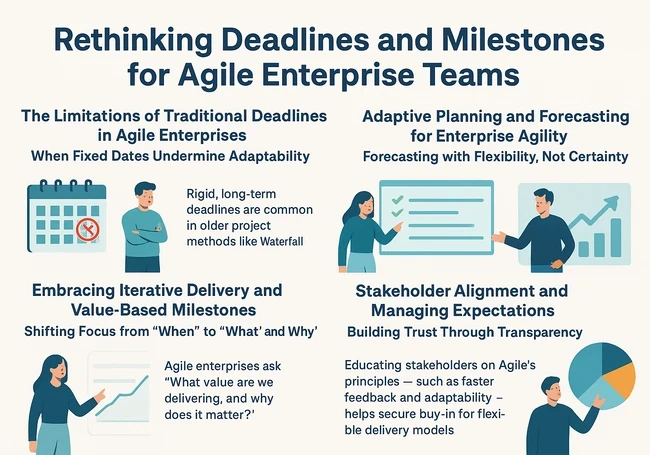The traditional, rigid deadline and milestone approach often clashes with the inherent flexibility and iterative nature of Agile methodologies. This is especially true within large enterprise environments. This disconnect can lead to team frustration, scope creep disguised as adaptation, and ultimately, projects that miss the mark.
This article explores why a fundamental shift in how enterprise Agile teams view and manage deadlines and milestones is not just helpful but essential for sustained success. We will delve into the pitfalls of rigid planning and offer clear strategies for adopting a more adaptive, value-driven approach.

The Limitations of Traditional Deadlines in Agile Enterprises
1. When Fixed Dates Undermine Adaptability
Rigid, long-term deadlines are common in older project methods like Waterfall. These strict end dates directly clash with core Agile ideas, which depend on constant feedback and the chance to make changes as we go. When dates are set too early, teams cannot truly be nimble.
2. The Illusion of Predictability
Upfront, fixed deadlines create a false sense of certainty. We might plan everything out, but unforeseen challenges like new tech problems or shifting customer expectations can quickly make these initial plans obsolete.
Embracing Iterative Delivery and Value-Based Milestones
1. Shifting Focus from "When" to "What" and "Why"
Instead of asking “When will it be done?”, Agile enterprises ask “What value are we delivering, and why does it matter?”. This simple shift prioritizes business goals and customer needs above arbitrary dates.
2. Defining Milestones by Achieved Value
Milestones can be tied to outcomes, not calendar points. Examples include:
“Launch of core user authentication feature”
“Successful A/B test demonstrating 15% conversion uplift”
Adaptive Planning and Forecasting for Enterprise Agility
1. Forecasting with Flexibility, Not Certainty
Agile teams can still plan for the future without committing to immovable dates, using techniques like probabilistic forecasting to provide realistic delivery ranges.
2. Utilizing Velocity and Throughput
Metrics such as velocity and throughput allow for more accurate forecasting without over-promising. For example, knowing a team delivers 30 story points per sprint helps estimate delivery time for larger backlogs.
Stakeholder Alignment and Managing Expectations
1. Building Trust Through Transparency
Educating stakeholders on Agile’s principles — such as faster feedback and adaptability — helps secure buy-in for flexible delivery models.
2. Establishing Release Cadences
Predictable release cadences (e.g., quarterly releases) offer stakeholders consistency without locking teams into unhelpful feature-specific deadlines.
Real-World Adaptations and Success Stories
1. Spotify’s Tribe and Squad Model
Spotify’s Agile model allows squads to release updates frequently, enabling responsiveness without rigid project deadlines.
2. Financial Institution Using Kanban
A large bank adopted Kanban to track lead time and cycle time, improving predictability and delivery flow without committing to fixed end dates.
3. Atlassian’s Continuous Delivery Approach
Atlassian uses continuous integration and delivery pipelines to deploy small, frequent updates. This ensures that value reaches customers as soon as it’s ready, eliminating the need for traditional milestone tracking.
4. Microsoft’s Shift to Feature Waves
In its Azure DevOps teams, Microsoft replaced rigid deadlines with “feature waves” — groups of related functionalities delivered when ready. This model allows features to be shipped independently without delaying overall releases.
Conclusion
Agile enterprise success depends on flexibility. Replacing rigid, date-driven deadlines with value-based milestones, adaptive forecasting, and transparent stakeholder communication leads to better quality, happier teams, and stronger business outcomes.
By focusing on continuous value delivery and adaptability, enterprise Agile teams can increase predictability, reduce burnout, and deliver better results in a fast-changing world.







Comments ( 0 )